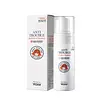What's inside
What's inside
 Key Ingredients
Key Ingredients

 Benefits
Benefits

 Concerns
Concerns

 Ingredients Side-by-side
Ingredients Side-by-side

Water
Skin ConditioningGlycerin
HumectantPotassium Cocoyl Glycinate
Disodium Laureth Sulfosuccinate
CleansingDecyl Glucoside
CleansingNiacinamide
SmoothingAloe Barbadensis Leaf Extract
EmollientLauryl Glucoside
CleansingCamellia Sinensis Leaf Extract
AntimicrobialCoco-Betaine
Cleansing1,2-Hexanediol
Skin ConditioningSea Water
HumectantAcrylates/C10-30 Alkyl Acrylate Crosspolymer
Emulsion StabilisingSorbitol
HumectantNelumbo Nucifera Leaf Extract
Skin ConditioningXanthan Gum
EmulsifyingTromethamine
BufferingOryza Sativa Extract
AbsorbentCitrus Unshiu Peel Extract
MaskingRosmarinus Officinalis Leaf Extract
AntimicrobialNelumbo Nucifera Root Extract
Skin ConditioningOpuntia Coccinellifera Fruit Extract
Skin ConditioningStyrene/Acrylates Copolymer
Citrus Limon Peel Oil
MaskingLavandula Angustifolia Oil
MaskingCitric Acid
BufferingButylene Glycol
HumectantDisodium EDTA
Sodium Benzoate
MaskingCitrus Aurantium Dulcis Peel Oil
MaskingPyrus Malus Fruit Extract
Skin ConditioningAllantoin
Skin ConditioningTrehalose
HumectantPanthenol
Skin ConditioningBenzoic Acid
MaskingBacillus/Soybean Ferment Extract
Skin ConditioningSodium Hyaluronate
HumectantFolic Acid
Skin ConditioningAloe Barbadensis Leaf Juice
Skin ConditioningWater, Glycerin, Potassium Cocoyl Glycinate, Disodium Laureth Sulfosuccinate, Decyl Glucoside, Niacinamide, Aloe Barbadensis Leaf Extract, Lauryl Glucoside, Camellia Sinensis Leaf Extract, Coco-Betaine, 1,2-Hexanediol, Sea Water, Acrylates/C10-30 Alkyl Acrylate Crosspolymer, Sorbitol, Nelumbo Nucifera Leaf Extract, Xanthan Gum, Tromethamine, Oryza Sativa Extract, Citrus Unshiu Peel Extract, Rosmarinus Officinalis Leaf Extract, Nelumbo Nucifera Root Extract, Opuntia Coccinellifera Fruit Extract, Styrene/Acrylates Copolymer, Citrus Limon Peel Oil, Lavandula Angustifolia Oil, Citric Acid, Butylene Glycol, Disodium EDTA, Sodium Benzoate, Citrus Aurantium Dulcis Peel Oil, Pyrus Malus Fruit Extract, Allantoin, Trehalose, Panthenol, Benzoic Acid, Bacillus/Soybean Ferment Extract, Sodium Hyaluronate, Folic Acid, Aloe Barbadensis Leaf Juice
Ingredients Explained
These ingredients are found in both products.
Ingredients higher up in an ingredient list are typically present in a larger amount.
Butylene Glycol (or BG) is used within cosmetic products for a few different reasons:
Overall, Butylene Glycol is a safe and well-rounded ingredient that works well with other ingredients.
Though this ingredient works well with most skin types, some people with sensitive skin may experience a reaction such as allergic rashes, closed comedones, or itchiness.
Learn more about Butylene GlycolCamellia Sinensis Leaf Extract is derived from the leaves of the tea plant. Black tea, green tea, and oolong tea are all harvested from this plant.
This ingredient has many skin benefits:
This ingredient contains polyphenols, a strong antioxidant. Antioxidants help fight off molecules that damage skin cells.
On top of that, the antioxidants in green tea neutralize free-radicals from the sun. This gives the skin some extra UV protection, but should not replace sunscreen.
Many components of tea have anti-inflammatory properties.
Polyphenols and L-theanine help soothe the skin and reduce irritation. The caffeine in Camellia Sinensis Leaf Extract helps calm inflamed blood vessels.
Other compounds found in tea include: Vitamin Bs, linoleic acid, magnesium, calcium, iron, and zinc.
Research has shown both drinking Camellia Sinensis Leaf Tea and applying it to the skin can help boost skin elasticity and hydration. Studies also show using tea extract may reduce sebum, or oil, production.
Learn more about Camellia Sinensis Leaf ExtractDisodium EDTA plays a role in making products more stable by aiding other preservatives.
It is a chelating agent, meaning it neutralizes metal ions that may be found in a product.
Disodium EDTA is a salt of edetic acid and is found to be safe in cosmetic ingredients.
Learn more about Disodium EDTAGlycerin is already naturally found in your skin. It helps moisturize and protect your skin.
A study from 2016 found glycerin to be more effective as a humectant than AHAs and hyaluronic acid.
As a humectant, it helps the skin stay hydrated by pulling moisture to your skin. The low molecular weight of glycerin allows it to pull moisture into the deeper layers of your skin.
Hydrated skin improves your skin barrier; Your skin barrier helps protect against irritants and bacteria.
Glycerin has also been found to have antimicrobial and antiviral properties. Due to these properties, glycerin is often used in wound and burn treatments.
In cosmetics, glycerin is usually derived from plants such as soybean or palm. However, it can also be sourced from animals, such as tallow or animal fat.
This ingredient is organic, colorless, odorless, and non-toxic.
Glycerin is the name for this ingredient in American English. British English uses Glycerol/Glycerine.
Learn more about GlycerinRosmarinus Officinalis Leaf Extract comes from rosemary. Rosemary is native to the Mediterranean.
While Rosmarinus Officinalis Leaf Oil can be volatile due to its fragrant properties, the fragrance components are usually removed in the leaf extract.
Rosemary Leaf Extract contains many antioxidants such as rosmarinic acid and caffeic acid. Rosemarinic acid, a compound found in rosemary leaf, has been found to help soothe skin conditions such as eczema and acne.
Learn more about Rosmarinus Officinalis Leaf ExtractWater. It's the most common cosmetic ingredient of all. You'll usually see it at the top of ingredient lists, meaning that it makes up the largest part of the product.
So why is it so popular? Water most often acts as a solvent - this means that it helps dissolve other ingredients into the formulation.
You'll also recognize water as that liquid we all need to stay alive. If you see this, drink a glass of water. Stay hydrated!
Learn more about Water